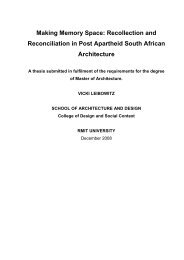Objects in Flux - RMIT Research Repository - RMIT University
Objects in Flux - RMIT Research Repository - RMIT University
Objects in Flux - RMIT Research Repository - RMIT University
Create successful ePaper yourself
Turn your PDF publications into a flip-book with our unique Google optimized e-Paper software.
<strong>Objects</strong> <strong>in</strong> <strong>Flux</strong><br />
1/ De Certeau l<strong>in</strong>ks these everyday<br />
ways of operat<strong>in</strong>g to our evolution-<br />
ary development and ‘the immemorial<br />
<strong>in</strong>telligence displayed <strong>in</strong> the tricks and<br />
imitations of plants and fishes’ (p.xix)<br />
14<br />
therefore not at all extraord<strong>in</strong>ary. 1 However, when faced with the nor-<br />
malized and highly scripted products of mass-production these actions<br />
take on an unusual and often disruptive quality. When objects of massproduction<br />
are re-made or re-contextualised the result can be arrest<strong>in</strong>g.<br />
The field of product design presents many examples of such practices,<br />
from the Castiglioni brothers’ mezzadro stool (1957); Charles Jencks’s<br />
Ad hoc radio; Nathan Silver’s D<strong>in</strong><strong>in</strong>g Chair (1968); Ron Arad’s Rover<br />
Chair (1981); Frank Schre<strong>in</strong>er’s Consumer’s Rest shopp<strong>in</strong>g cart chair<br />
(1983); Tom Dixon’s Creative Salvage group from 1984 and his latter<br />
publication Reth<strong>in</strong>k (2000); Jasper Morrison’s Readymade products<br />
from the 1980s, followed by Renny Ra<strong>in</strong>maker’s re-discovery of the<br />
practice <strong>in</strong> the 1990s with the numerous recycled and reused products<br />
grouped under the Droog brand; and the current abundance of<br />
recycled design objects from groups such as Castor Canadensis and<br />
Reestore. While this field provides a long and fasc<strong>in</strong>at<strong>in</strong>g history<br />
this research project is less concerned with strategies of professional<br />
design than it is with amateur production and the various uses and<br />
misuses <strong>in</strong>dividuals f<strong>in</strong>d for the objects <strong>in</strong> their possession.<br />
Such practices can often be found <strong>in</strong> situations where social, economic,<br />
or material constra<strong>in</strong>ts limit the availability of goods and services. Two<br />
recent publications, Home-Made, contemporary Russian folk artifacts<br />
by Vladimir Arkhipov (2006) and Prisoners’ Inventions by artist group<br />
Temporary Services (2003), give particularly <strong>in</strong>terest<strong>in</strong>g accounts of<br />
such practices. Home-Made, contemporary Russian folk artifacts documents<br />
Arkhipov’s collection of unique hand-made objects from the<br />
former Soviet Union. Presented together with stories of their creation,<br />
the book is a record of life under communism, where material shortages<br />
forced the general population to ‘make do’. The objects, improvised<br />
from the disparate materials available, present <strong>in</strong>novative and fasc<strong>in</strong>at<strong>in</strong>g<br />
solutions to the most mundane of problems: bicycle wheels and<br />
forks pressed <strong>in</strong>to service as television antennas, boot heels used as bath<br />
plugs and buckets remade as shovels. These <strong>in</strong>genious acts of material<br />
manipulation are born out of scarcity and need.<br />
Likewise, Prisoners’ Inventions documents tools developed with<strong>in</strong><br />
the restrictive environment of the United States penal system. These<br />
objects are easily understood <strong>in</strong> terms of function and necessity – here,<br />
that well-worn mantra ‘necessity is the mother of <strong>in</strong>vention’ r<strong>in</strong>gs true.
















